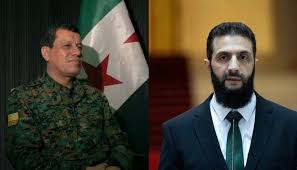As Syria navigates a period of political transition, the Syrian Democratic Forces (SDF) have reiterated their commitment to integrating into the Syrian army and strengthening ties with the new administration in Damascus. A high-level tripartite meeting between the SDF, the Syrian Democratic Council (SDC), and the Autonomous Administration of North and East Syria (AANES) has resulted in key agreements aimed at enhancing cooperation with the Syrian government. However, these developments unfold against the backdrop of a worsening humanitarian crisis triggered by the suspension of U.S. aid to Northeast Syria, which has severely impacted security, economic stability, and essential services.
Tripartite Meeting Advances Coordination with Damascus
The recent meeting in al-Hassakeh concluded with a commitment to integrating the SDF and the Autonomous Administration’s security institutions into the structure of the Syrian army. This step is intended to unify military efforts, reinforce national sovereignty, and facilitate the withdrawal of all non-Syrian fighters from the region. Additionally, the parties agreed to reactivate state-run civil and service institutions to improve living conditions and restore essential public services.
The meeting also underscored the need for intensified coordination with Damascus to stabilize the region and facilitate the return of displaced civilians. In a significant political gesture, SDF Commander-in-Chief Mazloum Abdi officially congratulated President Ahmad al-Sharaa on assuming the presidency and extended an invitation for him to visit northeastern Syria. This move aligns with broader efforts to bolster communication and political cooperation between the Autonomous Administration and the Syrian government.
The U.S. Aid Freeze Deepens Humanitarian and Security Challenges
As the SDF and Damascus engage in negotiations, the situation in Northeast Syria has deteriorated due to the recent suspension of U.S. aid. President Donald Trump’s executive order, which halted all foreign aid for 90 days except for emergency food assistance and military aid to Israel and Egypt, has significantly affected humanitarian operations, economic stability, and security in the region.
Humanitarian Crisis in IDP Camps
The aid freeze has had immediate and severe consequences for internally displaced persons (IDPs), particularly in camps such as al-Hol and Roj, which house over 42,500 individuals, many of whom are families of former ISIS fighters. The suspension of funding has:
- Disrupted essential services, including clean water, bread, and fuel distribution.
- Forced major humanitarian organizations, such as Blumont, Mercy Corps, and Save the Children, to suspend or scale back operations, resulting in mass layoffs.
- Increased security risks, as aid organizations play a key role in camp administration and safety.
Blumont, who managed several camps, was ordered by the U.S. State Department’s Bureau of Population, Refugees, and Migration to halt operations on January 24. While some temporary operations have resumed, the long-term outlook remains uncertain.
Security Implications and the Fate of ISIS Detainees
The aid suspension has exacerbated security concerns, particularly regarding the thousands of ISIS detainees held in SDF-run facilities. With Washington signalling that it will no longer indefinitely fund camp operations, foreign governments have been urged to repatriate their nationals. However, more than 9,000 foreign detainees from over 50 countries remain in legal limbo, raising fears of instability. Experts warn that the reduction in aid and security funding could lead to prison riots, jailbreaks, and a resurgence of ISIS cells.
Meanwhile, Damascus has insisted on greater control over security matters in northeastern Syria, including the transfer of ISIS detainees to the central government’s custody. The SDF has expressed willingness to coordinate but has maintained that regional security must be a joint effort to prevent extremist resurgence.
Strengthening Political and Military Ties Amid a Changing Landscape
Amid these challenges, the SDF said it remains committed to forming a unified Syrian army with a national identity, free from foreign influence. Abdi reaffirmed support for the restoration of central government institutions in northern and eastern Syria, viewing it as essential for reestablishing governance structures.
Since the fall of Bashar al-Assad’s regime in December, negotiations between the Damascus government and the SDF have been ongoing, though no formal agreement has been reached on all key issues. Syrian officials, including Defense Minister Marhaf Abu Qasra and President Ahmad al-Sharaa, have emphasized their preference for a diplomatic resolution rather than military confrontation.
International Mediation and Kurdish Unification Efforts
Parallel to negotiations with Damascus, the SDF and the international coalition—led by the United States and France—are facilitating dialogue among Kurdish factions to present a unified Kurdish delegation. A recent meeting in Qamishli brought together the Kurdish National Council (KNC) and the National Unity Parties, led by the Democratic Union Party (PYD), to work toward a cohesive political stance.
A senior KNC leader noted that “about 90% of the political visions and demands of Syrian Kurds are aligned.” However, some contentious points remain unresolved, with ongoing mediation efforts aimed at bridging differences.
The Road Ahead
As Syria undergoes a transitional period, the evolving relationship between the SDF and the government in Damascus will shape the country’s future governance and security framework. However, the aid crisis has further complicated the situation, posing new humanitarian, economic, and security risks.
Without urgent alternative funding sources, the region faces an increasingly precarious future. The international community must act swiftly to restore funding for critical humanitarian services, support local employment, and develop a clear strategy for handling ISIS detainees.
As diplomatic efforts continue, the stakes remain high for Syria’s stability, with ongoing talks between the SDF and Damascus standing at a crucial juncture. Whether these negotiations lead to lasting stability will depend on both parties’ ability to compromise and establish mechanisms for sustained
This article was translated and edited by The Syrian Observer. The Syrian Observer has not verified the content of this story. Responsibility for the information and views set out in this article lies entirely with the author.


